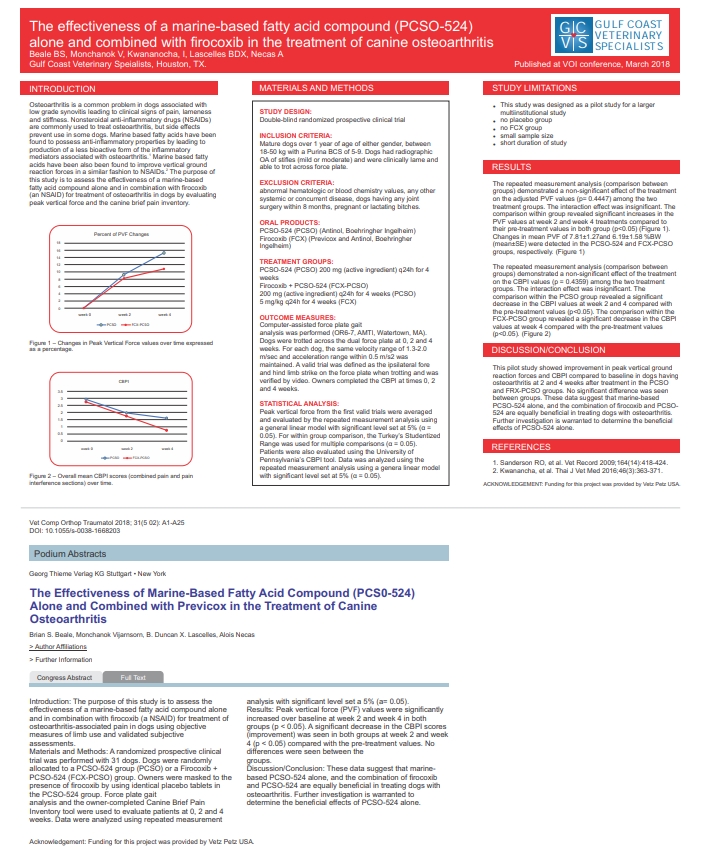The Effectiveness of Marine Based Fatty Acid Compound (PCSO-524) Alone and Combined with Firocoxib in the Treatment of Canine Osteoarthritis

(VOS conference, March 2018)

Executive Summary
This randomized study involved 31 mixed breed dogs with x ray confirmed OA of stifle joint.
They were split into 2 groups for four weeks of treatment;
1) PCSO-524 200 mg (4 caps) q24hr PO
and 2) Firocoxib (FCX) 5 mg/kg q24hr PO & PCSO-524 200 mg (4 caps) q24hr PO.
Outcome measures were Computer-assisted Force Plate gait analysis (OR6-7,AMTI, Watertown MA) and Owner assessment Canine brief pain inventory score (CBPI).
The results showed a non-significant effect of the treatment on the adjusted Peak Vertical Force (PVF) value (p=0.447) among the 2 treatment groups.
The comparison within group revealed significant increases in the PVF value at week 2 and week 4 in both treatment groups compared to their pretreatment values (p<0.05). Change in mean PVF of 7.81(±1.27) and 6.19(±1.8%BW) [mean(±SE)] were detected in PCSO-524 and FCX+PCSO-524 groups respectively.
CBPI values compared between the two groups was non-significant (p=0.4359).
CBPI comparison within the both groups showed significant decreases at 2 and 4 weeks compared with their pretreatment value (p<0.05).
Abstract
Introduction: The purpose of this study is to assess the effectiveness of a marine-based fatty acid compound alone and in combination with firocoxib (a NSAID) for treatment of osteoarthritis-associated pain in dogs using objective measures of limb use and validated subjective assessments.
Materials and Methods: A randomized prospective clinical trial was performed with 31 dogs. Dogs were randomly allocated to a PCSO-524 group (PCSO) or a Firocoxib + PCSO-524 (FCX-PCSO) group. Owners were masked to the presence of firocoxib by using identical placebo tablets in the PCSO-524 group. Force plate gait analysis and the owner-completed Canine Brief Pain Inventory tool were used to evaluate patients at 0, 2 and 4 weeks. Data were analyzed using repeated measurement analysis with significant level set a 5% (a= 0.05).
Results: Peak vertical force (PVF) values were significantly increased over baseline at week 2 and week 4 in both groups (p < 0.05). A significant decrease in the CBPI scores (improvement) was seen in both groups at week 2 and week 4 (p < 0.05) compared with the pre-treatment values. No differences were seen between the groups.
Discussion/Conclusion: These data suggest that marine-based PCSO-524 alone, and the combination of firocoxib and PCSO-524 are equally beneficial in treating dogs with osteoarthritis. Further investigation is warranted to determine the beneficial effects of PCSO-524 alone.
This pilot study showed improvement in peak vertical ground reaction forces and CBPI compared to baseline in dogs having osteoarthritis at 2 and 4 weeks after treatment in the PCSO and FRX-PCSO groups. No significant difference was seen between groups. These data suggest that marine-based PCSO-524 alone, and the combination of firocoxib and PCSO-524 are equally beneficial in treating dogs with osteoarthritis. Further investigation is warranted to determine the beneficial effects of PCSO-524 alone.


 Authors:
Authors: